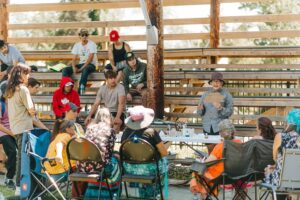The Anemki Wajiw mountain keepers create art with the help of Mother Earth

By Rick Garrick
FORT WILLIAM — The Anemki Wajiw mountain keepers enjoyed creating art with inks they made from plants and water from around the area through a Fort William First Nation-Lakehead University Climate Change and Health Adaptation project.
“It was very interesting using all the plants we harvested to make the paintings,” says Thatcher Bannon, a supervisor with the mountain keepers at Fort William. “We harvested some plants, we gave thanks, and [land-based Indigenous artist Betty Carpick] taught us how to boil down the plants into paints, and then each of us made our own Anemki Wajiw [painting].”
Bannon says the art the mountain keepers created was beautiful.
“It was the first time I’ve ever used things we found from nature to make art,” Bannon says. “It was very cool to see each one of them have their own interpretation of what the mountain means to them, and to see them express it through the art medium was wonderful.”
Bannon says the six-week mountain keepers program, which began on June 28, was a healing experience as they were constantly in nature and on the mountain.
“Taking care of the mountain was a healing experience … because I was able to give back,” Bannon says. “It’s been a healing experience as well being able to connect with the Elders and seeing the youth connect with the Elders.”
Fort William Elder Sheila DeCorte, a Water Walker involved with the For Love of the Rivers 2.0 Water Walk 2022’s four water walks this summer, says it was an honour to be involved with the project.
“I was asked to come and share the element of water,” DeCorte says. “I spoke to the youth about the importance of protecting and caring for the water through these water walk ceremonies, and encouraging them to come and join us on the Kaministiquia walk because the Kaministiquia River is very important to our community here in Fort William First Nation.”
DeCorte says they collected water for the paints from a spring on Anemki Wajiw, the Kaministiquia River and Lake Superior.
“That water was mixed into one of our medicines, the goldenrod, to make an ink for these paintings,” DeCorte says. “So that water is very important and significant in helping to make these inks.”
Carpick says she designed the project to enable the mountain keepers to connect to Anemki Wajiw, both today and in the past, through nature.
“They took the tobacco and did the gathering before this week,” Carpick says, noting that they created the inks and paintings from Aug. 8-10. “They gathered goldenrod and speckled alder, they also gathered some other plants and rocks and they gathered water from on and around Anemki Wajiw.”
Carpick says the mountain keepers used a template of Anemki Wajiw to create their paintings.
“It was pretty fun — they liked being involved in the process,” Carpick says. “There were kind of like surprises and magical parts they enjoyed. Some of them were saying they weren’t artistic, but I invited them just to play with the materials and to think about their own connection to the mountain, their family’s connection and what it means to take care of a place.”
Carpick says the goldenrod ink was made by simmering the goldenrod flowers in water over a fire and the charcoal ink was made by placing peeled branches in tins over a fire, grinding up the carbonized material and mixing it with water.
“And then the copper carbonate I made as just kind of a gesture to the legacy of copper for Indigenous people on Turtle Island,” Carpick says.


